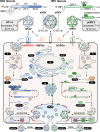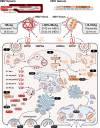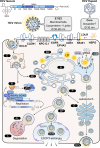[Viral hepatitis A to E: prevalence, pathogen characteristics, and pathogenesis]
- PMID: 34932130
- PMCID: PMC8813840
- DOI: 10.1007/s00103-021-03472-0
[Viral hepatitis A to E: prevalence, pathogen characteristics, and pathogenesis]
Abstract
Viral hepatitis is characterized as an acute or chronic inflammation of the liver induced by an infection with certain viruses. At present, around 325 million humans suffer from the chronic form of the disease worldwide. Each year, about 1.6 million people die as a result of viral hepatitis. The causative agents, hepatitis viruses, are subdivided into five groups of pathogens, which are denoted with the letters A to E (HAV to HEV). These differ from each other with respect to phylogeny, transmission, epidemiology, host-specificity, life cycle, structure, and distinct aspects of pathogenesis.The strictly human-pathogenic HAV, a member of the Picornaviridae family, mostly induces acute hepatitis and displays a dominant spread over the Global South. The Hepeviridae-affiliated HEV shows a similar epidemiology, yet spreads further into industrialized countries due to its zoonotic potential. Furthermore, HEV is defined by the capability of inducing chronic hepatitis. This course of disease is also found in a more pronounced manner for the globally prevalent HBV (Hepadnaviridae) and its satellite virus HDV (Kolmioviridae), which further increases their carcinogenic potential. Lastly, a worldwide distribution is similarly described for HCV (Flaviviridae), which displays a high risk of chronifications and therefore a highly increased carcinogenic potential.The aforementioned pathogens differ with respect to their properties and life cycles. Thus, a differentiated look on epidemiology, diagnostic procedures, and disease prevention is required. Despite the presence of therapies, in some cases even a vaccine, there is an urgent need for advances in research on these aspects, especially for poverty-related pathogens.
Bei der viralen Hepatitis handelt es sich um eine akute oder chronische Entzündung der Leber, die durch verschiedene Viren verursacht wird. Weltweit leiden derzeit ca. 325 Mio. Menschen an der chronischen Form. Jährlich versterben insgesamt ca. 1,6 Mio. an den Folgen einer viralen Hepatitis. Die Hepatitisviren werden in 5 Erregergruppen unterteilt, die mit den Buchstaben A bis E bezeichnet werden (HAV–HEV). Diese unterscheiden sich in Phylogenie, Übertragung, Epidemiologie, Wirtsspezifität, Lebenszyklus, Struktur und in speziellen Aspekten der Pathogenese.Das strikt humanpathogene HAV, Teil der Familie Picornaviridae, induziert meist nur akute Hepatitiden und ist primär in Entwicklungsländern verbreitet. Das den Hepeviridae zugeordnete HEV beschreibt eine ähnliche Epidemiologie, ist jedoch durch sein zoonotisches Potenzial auch in Industrienationen weitverbreitet und kann zusätzlich eine chronische Erkrankung induzieren. Eine Chronifizierung tritt ebenso bei dem weltweit verbreiteten HBV (Hepadnaviridae) auf, dessen Satellitenvirus HDV (Kolmioviridae) das vorhandene kanzerogene Potenzial noch einmal erhöht. Das ebenfalls weltweit verbreitete HCV (Flaviviridae) birgt ein äußerst hohes Risiko der Chronifizierung und somit ebenfalls ein stark erhöhtes, kanzerogenes Potenzial.Die Erreger der viralen Hepatitis unterscheiden sich in ihren Eigenschaften und Lebenszyklen. Eine differenzierte Betrachtung im Hinblick auf Epidemiologie, Nachweismethoden und Prävention ist daher angezeigt. Obwohl robuste Therapien, und im Falle einzelner Erreger auch Vakzine, vorhanden sind, muss die Forschung insbesondere in Hinblick auf die armutsassoziierten Erreger erheblich vorangetrieben werden.
Keywords: Hepatitis; Hepatitis viruses; Life cycle; Pathogenesis; Structure.
© 2021. The Author(s).
References
Publication types
MeSH terms
LinkOut - more resources
Full Text Sources




